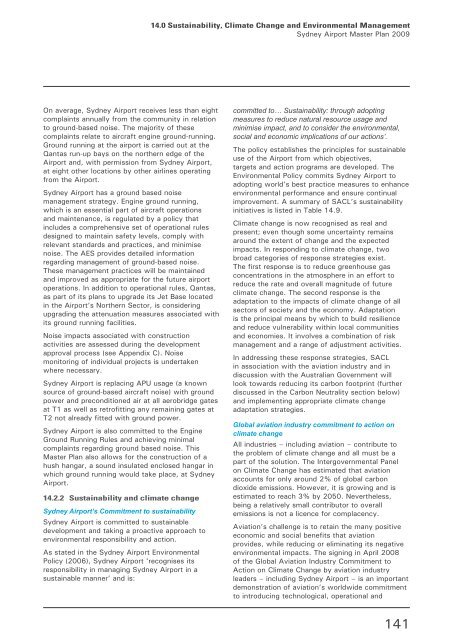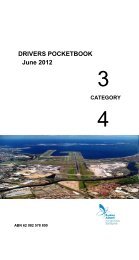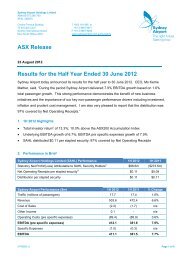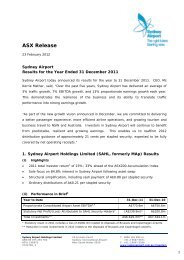Master Plan 2009 - Sydney Airport
Master Plan 2009 - Sydney Airport
Master Plan 2009 - Sydney Airport
You also want an ePaper? Increase the reach of your titles
YUMPU automatically turns print PDFs into web optimized ePapers that Google loves.
On average, <strong>Sydney</strong> <strong>Airport</strong> receives less than eight<br />
complaints annually from the community in relation<br />
to ground-based noise. The majority of these<br />
complaints relate to aircraft engine ground-running.<br />
Ground running at the airport is carried out at the<br />
Qantas run-up bays on the northern edge of the<br />
<strong>Airport</strong> and, with permission from <strong>Sydney</strong> <strong>Airport</strong>,<br />
at eight other locations by other airlines operating<br />
from the <strong>Airport</strong>.<br />
<strong>Sydney</strong> <strong>Airport</strong> has a ground based noise<br />
management strategy. Engine ground running,<br />
which is an essential part of aircraft operations<br />
and maintenance, is regulated by a policy that<br />
includes a comprehensive set of operational rules<br />
designed to maintain safety levels, comply with<br />
relevant standards and practices, and minimise<br />
noise. The AES provides detailed information<br />
regarding management of ground-based noise.<br />
These management practices will be maintained<br />
and improved as appropriate for the future airport<br />
operations. In addition to operational rules, Qantas,<br />
as part of its plans to upgrade its Jet Base located<br />
in the <strong>Airport</strong>’s Northern Sector, is considering<br />
upgrading the attenuation measures associated with<br />
its ground running facilities.<br />
Noise impacts associated with construction<br />
activities are assessed during the development<br />
approval process (see Appendix C). Noise<br />
monitoring of individual projects is undertaken<br />
where necessary.<br />
<strong>Sydney</strong> <strong>Airport</strong> is replacing APU usage (a known<br />
source of ground-based aircraft noise) with ground<br />
power and preconditioned air at all aerobridge gates<br />
at T1 as well as retrofitting any remaining gates at<br />
T2 not already fitted with ground power.<br />
<strong>Sydney</strong> <strong>Airport</strong> is also committed to the Engine<br />
Ground Running Rules and achieving minimal<br />
complaints regarding ground based noise. This<br />
<strong>Master</strong> <strong>Plan</strong> also allows for the construction of a<br />
hush hangar, a sound insulated enclosed hangar in<br />
which ground running would take place, at <strong>Sydney</strong><br />
<strong>Airport</strong>.<br />
14.2.2 Sustainability and climate change<br />
<strong>Sydney</strong> <strong>Airport</strong>’s Commitment to sustainability<br />
<strong>Sydney</strong> <strong>Airport</strong> is committed to sustainable<br />
development and taking a proactive approach to<br />
environmental responsibility and action.<br />
As stated in the <strong>Sydney</strong> <strong>Airport</strong> Environmental<br />
Policy (2006), <strong>Sydney</strong> <strong>Airport</strong> ‘recognises its<br />
responsibility in managing <strong>Sydney</strong> <strong>Airport</strong> in a<br />
sustainable manner’ and is:<br />
14.0 Sustainability, Climate Change and Environmental Management<br />
<strong>Sydney</strong> <strong>Airport</strong> <strong>Master</strong> <strong>Plan</strong> <strong>2009</strong><br />
committed to… Sustainability: through adopting<br />
measures to reduce natural resource usage and<br />
minimise impact, and to consider the environmental,<br />
social and economic implications of our actions’.<br />
The policy establishes the principles for sustainable<br />
use of the <strong>Airport</strong> from which objectives,<br />
targets and action programs are developed. The<br />
Environmental Policy commits <strong>Sydney</strong> <strong>Airport</strong> to<br />
adopting world’s best practice measures to enhance<br />
environmental performance and ensure continual<br />
improvement. A summary of SACL’s sustainability<br />
initiatives is listed in Table 14.9.<br />
Climate change is now recognised as real and<br />
present; even though some uncertainty remains<br />
around the extent of change and the expected<br />
impacts. In responding to climate change, two<br />
broad categories of response strategies exist.<br />
The first response is to reduce greenhouse gas<br />
concentrations in the atmosphere in an effort to<br />
reduce the rate and overall magnitude of future<br />
climate change. The second response is the<br />
adaptation to the impacts of climate change of all<br />
sectors of society and the economy. Adaptation<br />
is the principal means by which to build resilience<br />
and reduce vulnerability within local communities<br />
and economies. It involves a combination of risk<br />
management and a range of adjustment activities.<br />
In addressing these response strategies, SACL<br />
in association with the aviation industry and in<br />
discussion with the Australian Government will<br />
look towards reducing its carbon footprint (further<br />
discussed in the Carbon Neutrality section below)<br />
and implementing appropriate climate change<br />
adaptation strategies.<br />
Global aviation industry commitment to action on<br />
climate change<br />
All industries – including aviation – contribute to<br />
the problem of climate change and all must be a<br />
part of the solution. The Intergovernmental Panel<br />
on Climate Change has estimated that aviation<br />
accounts for only around 2% of global carbon<br />
dioxide emissions. However, it is growing and is<br />
estimated to reach 3% by 2050. Nevertheless,<br />
being a relatively small contributor to overall<br />
emissions is not a licence for complacency.<br />
Aviation’s challenge is to retain the many positive<br />
economic and social benefits that aviation<br />
provides, while reducing or eliminating its negative<br />
environmental impacts. The signing in April 2008<br />
of the Global Aviation Industry Commitment to<br />
Action on Climate Change by aviation industry<br />
leaders – including <strong>Sydney</strong> <strong>Airport</strong> – is an important<br />
demonstration of aviation’s worldwide commitment<br />
to introducing technological, operational and<br />
141







